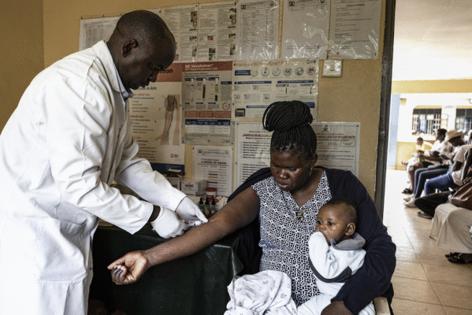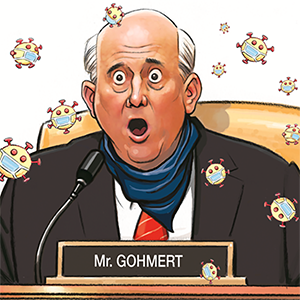Lisa Jarvis: When an HIV scientific breakthrough isn't enough
Published in Op Eds
A landmark breakthrough in HIV prevention — a scientific feat decades in the making — received final approval from the Food and Drug Administration last month. Gilead Sciences’ lenacapavir is so effective that global health leaders had started to cautiously talk about the end of an epidemic that continues to kill more than 600,000 people each year.
We should be celebrating its arrival.
Instead, aid groups and the countries most affected by HIV are reeling from the Trump administration’s relentless attacks on the global health infrastructure. Instead of perfecting plans for a rollout of the medication, they are scrambling to ensure people with HIV have the drugs they need to survive.
Last year, I wrote about the stunning — or as one HIV expert described it, “spine-chilling”— results from a large study of lenacapavir. None of the women and adolescents who were given the twice-yearly injection in the trial became infected with HIV. In a second study involving men who have sex with men, and transgender individuals who have sex with men, the treatment was 96% effective. Even better, Gilead is working on a newer version that could potentially offer protection for a year or more.
That’s about as close to an HIV vaccine we’re likely to get — at least for many years. It’s also the world’s best shot of achieving the goal of ending HIV by 2030.
For low- and middle-income countries that continue to face frustratingly stubborn infection rates, a twice-yearly drug could be a game-changer. Although existing treatments of daily pills do an excellent job at preventing infection, getting people to use them consistently has been difficult.
There is the stigma attached to the pills. Ensuring patients return for frequent testing and refills is also challenging — as is simply remembering to take them daily. Consider the typical day of a mom with a newborn and it’s easy to understand how six months of protection could make a real difference in lowering HIV cases in women and infants.
Some experts have even suggested lenacapavir is our best chance of wiping out new infections in children.
That was before the Trump administration abruptly shut down USAID, the lead agency behind Pepfar. The global initiative to combat HIV/AIDS is credited with saving an estimated 26 million lives since its inception in 2003. Although the administration granted a limited waiver to allow some HIV services to continue, funding is significantly restrained.
As health workers grapple with fewer resources, their focus has shifted to people living with HIV. “When the chips are down, you safeguard treatment because those people will die if they don’t get their antiretroviral,” says Linda-Gail Bekker, director of the Desmund Tutu HIV Centre at the University of Cape Town. And yet, she said, “prevention we know is an absolute cornerstone to bringing this epidemic under control.”
Because the situation is so dynamic, it’s been difficult to capture what’s happening on the ground. The best current model suggests the administration’s actions could result in at least 70,000 additional new infections, and another 5,000 deaths in the next five years.
UCLA infectious disease epidemiologist Dvora Joseph Davey says that in 2024, the eight public health clinics in Cape Town — where she is based — saw three infants who were HIV-positive at birth. In the first five months of this year, they’ve already seen three babies born with the infection.
She knows there will be more. One pregnant woman with HIV recently came into the clinic and, at 37 weeks, her viral load was dauntingly high. She’d skipped picking up her last three-month supply of pills. The nurse she’d been seeing was let go as part of the funding cuts, and no one was available to do a blood draw at her last visit, Davey says.
If the people who, in theory, should still be benefiting from global aid are falling through the cracks, what hope do we have for prevention?
Prevention efforts have already been severely disrupted in some countries. Supply is responsible for some of the upheaval, but the more complicated problem is getting the drugs to the people who need them most. “We need low-cost product and also a low-cost delivery mode,” says Carmen Pérez Casas, senior strategy lead at Unitaid, a global health initiative hosted by the World Health Organization. The situation for the latter “has changed radically,” she says.
HIV prevention is not as simple as just handing out a prescription. It’s first identifying those most at risk of infection, getting them tested to confirm they are negative, and offering counseling about their options. It’s ensuring they return for more testing and the next dose of their medication. That requires a vast support network ranging from doctors and nurses to counselors, pharmacists, lab technicians, data scientists and more.
Pepfar supported all of that infrastructure. In South Africa, for example, cuts have resulted in lost jobs for some 8,000 health workers focused on HIV.
Aid groups are doing their best to ensure the breakthrough’s promise is not entirely lost. Their first hurdle is bridging the gap to the arrival of low-cost generic lenacapavir, which isn’t expected until sometime in 2027. (Gilead is allowing a handful of drug companies to make and sell generic forms of lenacapavir in the countries most heavily impacted by HIV.) Global health agencies are anxiously awaiting the company’s price tag for those countries to understand how far their funding can be stretched.
Then they need to get the drug to patients. Experts tell me they’ve scaled back their expectations given the upheaval with Pepfar. The Trump administration’s termination of National Institutes of Health grants to foreign countries has created additional hurdles. It’s been particularly devastating in South Africa, where the NIH supported a significant chunk of research related to HIV. That means less money to conduct so-called implementation studies for lenacapavir, which are crucial for understanding how to improve the drug’s use in the real world. One simple thing the Trump administration could do is free up funding for prevention. Pepfar continues to operate under a waiver that only allows PrEP money to be spent for those who are pregnant or breastfeeding.
Groundbreaking science alone won’t end HIV. It must be paired with affordability and access. The Trump administration’s callous cuts to global health efforts put all of those things at risk — including the promising future where HIV is brought to heel.
_____
This column reflects the personal views of the author and does not necessarily reflect the opinion of the editorial board or Bloomberg LP and its owners.
Lisa Jarvis is a Bloomberg Opinion columnist covering biotech, health care and the pharmaceutical industry. Previously, she was executive editor of Chemical & Engineering News.
_____
©2025 Bloomberg L.P. Visit bloomberg.com/opinion. Distributed by Tribune Content Agency, LLC.

























































Comments